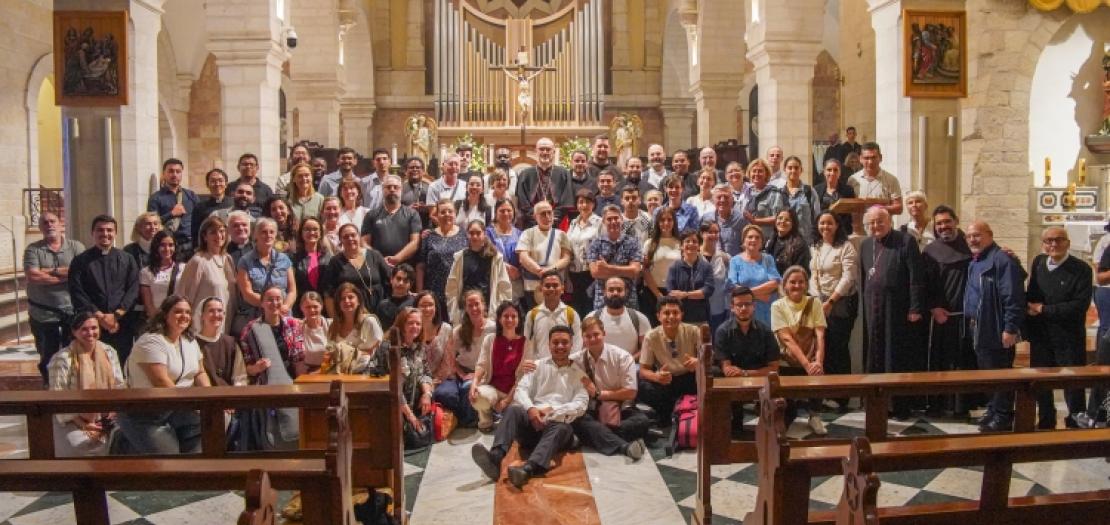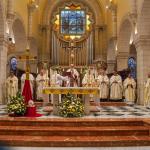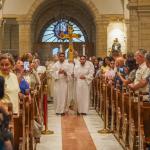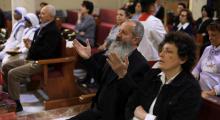Issued by the Catholic Center for Studies and Media - Jordan. Editor-in-chief Fr. Rif'at Bader - موقع أبونا abouna.org
On November 1, 2025, the Feast of All Saints, hundreds of faithful from across the Holy Land gathered in Bethlehem for a Pilgrimage for Peace, organized by the Ecclesial Movements and New Communities in the Holy Land. The event, held within the framework of the Jubilee of Hope celebrations, was a visible sign of unity and renewal in a land longing for peace.
Walking together for peace and hope
The day began at the Catholic Action Center in Bethlehem, where participants from Nazareth, Galilee, Jerusalem, and the Bethlehem governorate set out in procession through the narrow streets of the old city. With rosaries in hand and hymns on their lips, they made their way toward the Milk Grotto, pausing to share life testimonies and prayers that rekindled hope among the crowd. The journey continued toward the Basilica of the Nativity, where His Beatitude Cardinal Pierbattista Pizzaballa, Latin Patriarch of Jerusalem, presided over the concluding Eucharistic celebration.
“Today marked me as we walked these narrow streets of Bethlehem together, declaring our faith aloud,” shared a pilgrim from Nazareth. “We were able to bring a spirit of hope and joy to others in this city.”
Before Mass, pilgrims were invited to a moment of Eucharistic Adoration, and many received the Sacrament of Reconciliation, with bishops and priests from across the diocese present to hear confessions.
The Mass was concelebrated by Msgr. William Shomali, General Vicar, Msgr. Rafiq Nahra, Patriarchal Vicar in Galilee, Msgr. Bolous Marcuzzo, and Msgr. Ilario Antoniazzi, as well as Fr. Raphel, new Parish priest of Bethlehem, and many other priests from across the diocese. Among the assembly were representatives from the french and italian consulate, as well as the muncipality of Bethlehem.
A call to begin anew
In his homily, Cardinal Pizzaballa expressed first his joy in seeing a collaboration among various movements in the Diocese, embodying the Synodality, calling it as “a beautiful sign of Church belonging.”
While reflecting on the first reading from the Book of Revelation — “Do not damage the land or the sea or the trees until we put the seal on the foreheads of the servants of our God” — the Patriarch spoke of the children of God's presence in this world as “those who prevent total devastation,” noting that although they endure much suffering yet their presence prevents much.
“The presence of the children of God in the world holds back destruction,” he said. “They are sealed, belonging to God. Their robes are washed in the blood of the Lamb, which is a sign of the mystery of Easter, meaning: to give one's life out of love for God.” From there he invited the faithful to live out the Gospel reading of the beatitudes, which focuses on living not for oneself but for others: "In our land and our time, we are in need of children of God who are willing to stop the devastation we see around us, to offer their lives for others out of love. We must not fall into the temptation of seeking results. God Himself is our salvation. At times, we may not see the fruits of what we are sowing, yet what moves is the desire to communicate the grace we have received... like the saints before us!
He reminded the faithful that the saints, whose feast was being celebrated that day, were not perfect or untouched by suffering — but were people who offered their lives in service of the Church and the world.
“The saints did not live for themselves,” he continued. “They offered their lives doing something good for others, often paying a high price for it. They are like us — ordinary people who have experienced the mystery of salvation and wanted to share it.”
Turning to the new movements and communities, Cardinal Pizzaballa encouraged them to live out their mission in unity with the Church. “You help us look beyond our own boundaries, enclosing on one's self, that the culture of this land often faces. The Holy Spirit inspires new realities through you,” he said. “But always remember to walk together in unity with the Church. Our starting point is Jesus Christ, and our destination is Jesus Christ.”
He concluded by inviting the faithful to embrace the Jubilee as a moment of renewal and courage: "Today, as we celebrate the Jubilee, we are invited to begin anew — for every Jubilee marks a new beginning in the life of the Church, calling us to live as children of God, not only to halt the devastation around us but also to help build the Kingdom of God".
“Our life is a pilgrimage”
For many, the pilgrimage was more than a moment of prayer, it was an encounter.
Anne Marie, a member of the Regnum Christi Movement from France who helped organize the day, described it as “a moment of consolation and hope.”
“Our life is a pilgrimage,” she told the Media Office. “We follow Jesus on this earthly journey to meet Him in eternity. Walking the same path that Mary and Joseph once took to bring Christ into the world, we too carried the hope of Christ in us — a hope that is still unseen, but alive.”
She added that many local residents who witnessed the procession were moved by the joyful hymns and prayers echoing through Bethlehem’s streets.
“It has been a long time since the Old City has seen so many people. Pilgrims from abroad have been unable to come for two years, but today we brought a glimpse of that spirit back. Thanks be to God.”
The day concluded in gratitude — for the collaboration of parish priest, the Scouts who accompanied the procession, and the Catholic Action that opened its doors to the participants.
This pilgrimage, born from a simple idea among the 10 different Ecclesial and new Movements— to open their annual gathering to all during the Jubilee year — became a living testimony of unity and renewal. Ten different movements and new communities were represented, each bringing their own charism, color, and vitality to the life of the Church in the Holy Land.
In the heart of Bethlehem, on this Jubilee of Hope, that life was seen, sung, and shared once again.













